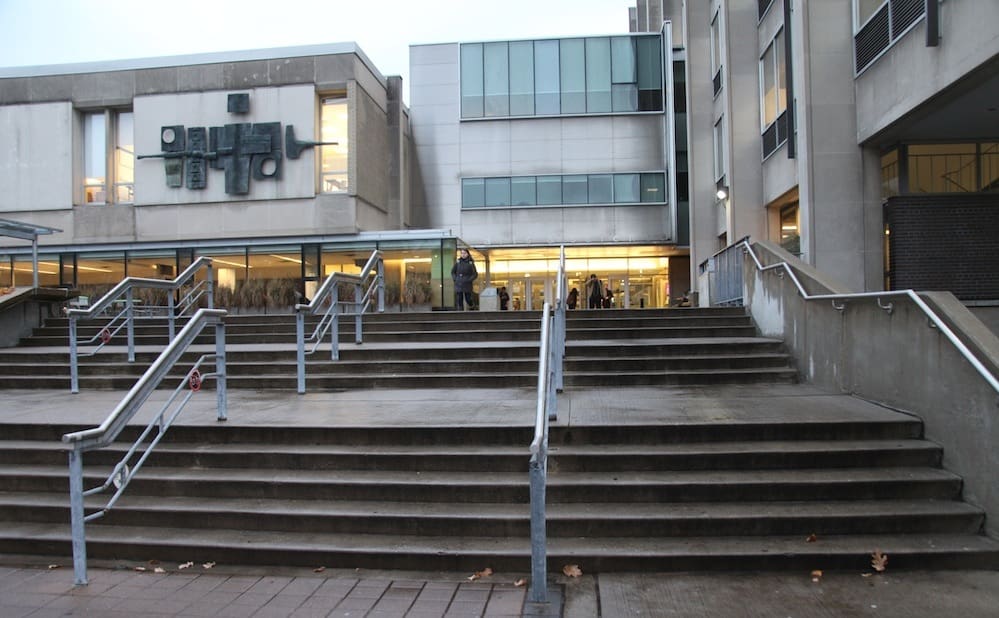The University of Toronto remains inaccessible to its students in a number of ways. Below, Comment contributors reflect on access to campus spaces, note-taking through Accessibility Services, and the need for comprehensive and detail-oriented accommodation.

Providing notes to those who need them should be a shared effort
Considering the number of laptops you see in any given class at U of T, you’d think that finding a note-taker would be pretty easy. This is false. I am 17 credits into my degree and, at my personal estimate, about 60 per cent of my courses have had note-takers. That means the other 40 per cent of the time, if I’ve had to miss class for disability-related reasons, I am without notes. Certain professors agree to send their personal lecture notes to make up for the gap, which I am very grateful for, but often I am left with nothing.
To be a note-taker, a student must simply upload their notes to the Accessibility Services website. If notes are handwritten, they are scanned and uploaded. If a student puts in a request for a note-taker in a given course, the instructor receives notice and is required to pass it on to the students — after that, their job is done.
More effort from all parties is necessary to ensure students get the notes they need. If no one volunteers following the sharing of the notice, it then becomes my job to pester the instructor. I am very unapologetic about my disability, so it puts me in an uncomfortable position when I’m apologizing to a prof for nagging them. Beyond that, I don’t want to have to make time so that my basic rights as a student can be met.
By nature of having a disability, I’m arguably working harder than a regular student to achieve the same levels in my work. The two minutes it takes for a student to upload their notes saves me a lot of unnecessary stress. Admittedly, Accessibility Services provides little incentive to attract volunteers beyond a nice little certificate. However, the good karma will do you wonders in your next life, and you can also put it on your Tinder profile to show the world that you are a good person. Swipe right for caring about others.
Elspeth Arbow is a fifth-year student at Innis College studying Cinema Studies and Buddhism, Psychology and Mental Health Studies.
![]()
![]()

Committing to accessibility means being attuned to the finer details
Conversations about accessibility tend to centre on salient concerns like doors not having automatic-open functions or buildings lacking elevators. What aren’t discussed as much are the arbitrary, near-imperceptible ways in which environments assume full mobility. Most architectural sites are constructed with able-bodiedness in mind; accessibility concerns are an afterthought, if they are acknowledged at all.
Disabled people are frequently reminded of this process of construction as we navigate the university campus, and it is a continuous cause of frustration. Ableist assumptions underlie every facet of man-made space. The Koffler Centre has a wheelchair ramp and automatic door fitted to the side entrance, but if I want to replace my TCard, I’ll have to stand in line. At the beginning of the semester, hundreds of people stood in line at the TCard office. With wait times potentially reaching several hours, no chairs were made available, nor was any sort of ticket-number queue system implemented as a more accessible option.
Accessing almost every service at UTSG similarly assumes the ability to stand, wait, and walk for as much time is needed. To consult with a registrar’s office representative at Wetmore Hall of New College, a student has to stand at the four-foot-high counter. And if, God forbid, a student wants to grab a coffee, they had better be willing and able to stand in line for as long as necessary.
The Accessibility for Ontarians with Disabilities Act of 2005 mandates that certain accessibility standards be implemented in built environments. The university has been taking steps to meet them, but the act only deals with that which is overtly and generally inaccessible, without offering a full environmental critique.
In an attempt to conform to legislative accessibility standards, the first-floor classrooms at Sidney Smith Hall were fitted with automatic doors, and some of the desks were made wheelchair-accessible. Yet the podiums at the front of the rooms can only be reached by stepping onto a platform. It is these kinds of ableist assumptions that underlie false attempts at addressing environmental accessibility concerns — that spaces only need to be accessible insofar as is mandated legally, and insofar as moral righteousness demands.
Meera Ulysses is a second-year student at New College studying Middle Eastern Studies and Equity Studies.

With respect to campus heritage buildings, barriers to access remain pervasive
University of Toronto students may feel marginalized when they cannot access their classes on campus. While the university is diligent in providing students with maps of all three campuses and issuing building access notices, many places on campus remain physically inaccessible to members of the student body.
As a public institution, the university has a legal obligation to adhere to the amended guidelines set forth in both the Design of Public Spaces Standard and the Ontario Building Code Amendments. However, both pieces of legislation apply only to the construction of new or extensively renovated buildings. Heritage buildings, which exist in abundance at U of T, pose various structural constraints that hinder the capacity to conduct major renovations. Such constraints leave many buildings without elevators, accessible washrooms, ramps, and powered doors.
A heritage structure like Teefy Hall, built in 1936, possesses none of these features. Convocation Hall, opened in 1907, has no elevator.
Even when the basic building blocks of physical accessibility are available, barriers remain. It is up to the university to ensure that all accessible entrances are maintained throughout the winter months. Students also remain reliant on the presence of adequate visible signage indicating the precise location of accessible entrances, especially when they are not visible from the street. All in all, the current state of affairs could deter students from registering for courses taught in specific buildings.
Regardless of structural constraints, the university must find alternative solutions to render its heritage buildings more accessible to all students. Installing powered doors and ramps, for instance, likely has no bearing on the structural composition of the building. Simple additions such as these recognize and accommodate the needs of students with accessibility concerns, thereby encouraging greater inclusivity.
Vittoria Di Paola is a student at U of T.


